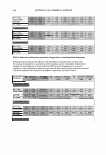50 45 CIJ "i 40 .J 35 � 30 ,! 25 � a, � 20 CD a, 15 CD � 10 5 0 Liquid makeup ASSESSMENT OF OCULAR IRRITANCY 323 Shampoo Baby wash Eye makeup remover Mascara Po'A{:ler eye Facial cleanser shadow Figure 4. The distribution of weighted scores of area and density of fluorescein staining patterns. jective reports of irritation and objective ophthalmic scores, as well as fluorescein stain ing patterns, were observed during the post-instillation examinations. The average subjective irritation scores for all product types peaked at 30 seconds post-instillation and decreased markedly at the 5 minute examination, with the exception of powder eye shadow, which decreased at 15 minutes post-instillation (Figure SA). Objective oph thalmic irritation was observed in various patterns (Figure SB). Objective irritations decreased at the 5 minute examination for liquid makeup, mascara, eye makeup remover, and powder eye shadow, and at the 60 minute examination for shampoo and baby wash. However, objective irritation for facial cleanser persisted at 120 minutes following ocular instillation. The average weighted scores (Figure SC) of fluorescein ophthalmic staining of ocular tissues revealed that superficial punctate staining peaked at 15 min utes post-instillation for shampoo, baby wash, eye makeup remover, mascara, and pow der eye shadow, and at 60 minutes post-instillation for liquid makeup and facial cleanser. Most ocular irritation resolved after 24 hours. The statistical analysis of weighted scores for fluorescein staining at post-instillation examination intervals dem onstrated a very good correlation (r 0.95) between facial cleanser, shampoo, or powder eye shadow and baby wash, and a fair correlation (r 0.75) between powder eye shadow or facial cleanser and mascara (Table III). CONCLUSIONS Based on the comparison analysis of the limited data in each product category, this study has demonstrated that subjective irritation reports, objective ocular irritation, and fluo rescein staining patterns attenuated rapidly during the two-hour study period for all categories except facial cleanser. Mascara and powder eye shadow elicited more subjective ocular discomfort shampoo and baby wash exhibited higher objective ocular irritation scores and shampoo, baby wash, and powder eye shadow elicited greater ocular tissue
324 35 1t1 C - 0 3 111- .. • .! .J'C7,5 e -= g -� 2 (/) .. a, • 1.5 Iii e :i 1 • II) 0 o.5 45 H 4 t j 3.5 .J .t:: et 3 g � 2.5 (/) &l £ 8 1.5 ... 0 1 0.5 35 GI 30 • a, ...I C rs 25 oS (/) (/) 20 tJ .5 ,SI GI s:. 0 ·? e ,s g & ii: 10 I! 'o JOURNAL OF COSMETIC SCIENCE A Baseline 30" B Baseline 30' C Baseline 30' 5' 15' Time of Evaluation 15' Time of Evaluation 5' 15' Time of Evaluation 60' 60' 60' + Liquid makeup +Shampoo +Babywash * Eye makeup remover +Mascara + Powder eye shadow +Facial cleanser 120' 24h 120' 24h 120' 24h Figure 5. Average score levels of ocular irritation at post-instillation evaluation intervals. staining than the remaining product types, in which mascara exhibited the lowest correlation between subjective response and objective irritation. Epithelial defects of the ocular surface were observed at later post-instillation evaluations, compared to the subjective responses and objective irritation, in which facial cleanser, shampoo, baby
Purchased for the exclusive use of nofirst nolast (unknown) From: SCC Media Library & Resource Center (library.scconline.org)






































































































